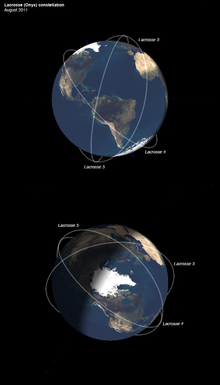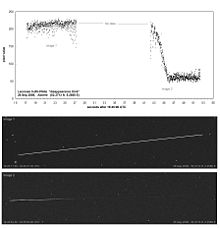- Lacrosse (satellite)
-
 Lacrosse 4, under construction[citation needed]
Lacrosse 4, under construction[citation needed]
For the 2009 Lunar Impactor Mission designed to crash into the moon, see LCROSS.
Lacrosse and Onyx are the code names for the United States' National Reconnaissance Office terrestrial radar imaging reconnaissance satellite. While not officially confirmed by the NRO or anybody in the U.S. government, for a long time, there was and is widespread evidence to confirm its existence, including one NASA website.[1] In July 2008, the NRO itself declassified the existence of their SAR satellite constellation.[2][3]
According to former Director of Central Intelligence Admiral Stansfield Turner, Lacrosse had its origins in 1978 when a dispute between the Central Intelligence Agency and the U.S. Air Force as to whether a combined optical/radar reconnaissance satellite (the CIA proposal) or a radar-only one (the USAF proposal) should be developed was resolved in favor of the USAF.
Lacrosse uses Synthetic Aperture Radar as its prime imaging instrument.[4][5] It is able to see through cloud cover and also has some ability to penetrate soil, though there have been more powerful instruments deployed in space for this specific purpose. Early versions are believed to have used the Tracking and Data Relay Satellite System (TDRSS) to relay imagery to a ground station at White Sands, New Mexico[citation needed]. There are some indications that other relay satellites may now be available for use with Lacrosse. The name "Lacrosse" is used to refer to all variants, while "Onyx" is sometimes used to refer to the three newer units[citation needed].
Unit costs (including launch) in 1990 dollars are estimated to be in the range of US $ 0.5 to 1.0 billion (inflation adjusted US$ 0.84 to 1.68 billion in 2011).[6]
Contents
Future
It has been said[citation needed] that the B-2 bomber was originally intended to use directly down-linked targeting data from Lacrosse satellites in order to aid it in its role of hunting down and destroying Soviet mobile ICBM launchers. It had been anticipated that the Lacrosse satellites would be replaced by the radar component of the Future Imagery Architecture (FIA). The severe program problems encountered by FIA in the early 2000s appear to have led to off-loading of radar reconnaissance to the Space Based Radar, later simplified to Space Radar, with initial launch anticipated around 2015.[7] This program itself was axed by Congress late 2008.[5] The launch of NROL-41 (USA 215) in September 2010 has all orbital characteristics of a radar remote sensing platform (see FIA) and could be the first of a Lacrosse follow-up program. Its orbit is a retrograde version of the "frozen" Lacrosse orbit,[8] the choice for a retrograde orbit itself indicating a SAR role.[9]
Launches
Five Lacrosse spacecraft have been launched, with three currently in orbit.
- Lacrosse 1: "Lacrosse 3000"
- Launch: December 2, 1988
- Platform: Space Shuttle Atlantis, mission STS-27
- Pad: Kennedy Space Center, Launch Complex 39B
- Orbital apogee/perigee/inclination: 447 × 437 km @ 57.0°
- Orbital period: 93.4 minutes
- De-orbit: 1997
- Status: Fulfilled mission, deorbited.
- NORAD Number: 19671(USA 34) COSPAR ID: 1988-106B
- Lacrosse 2:
- Launch: March 8, 1991
- Platform: Titan IV-A
- Pad: Vandenberg AFB, Space Launch Complex 4
- Orbital apogee/perigee/inclination: 662 × 420 km @ 68.0°
- De-orbit: March 26, 2011 [1]
- NORAD Number: 21147 (USA 69) 1991-017A
- Notes: The first West Coast launch of a Titan IV.
- Lacrosse 3:
- Launch: October 24, 1997
- Platform: Titan IV-A
- Pad: Vandenberg AFB, Space Launch Complex 4
- Orbital apogee/perigee/inclination: 679 × 666 km @ 57.0°
- Status: In active service
- NORAD Number: 25017 (USA 133) 1997-064A
- Notes: Replacement for Lacrosse 1.
- Lacrosse 4:
- Launch: August 17, 2000
- Platform: Titan IV-B
- Pad: Vandenberg AFB, Space Launch Complex 4
- Orbital apogee/perigee/inclination: 695 × 689 km @ 68.0°
- Mass: 14,500 kg
- Status: In active service
- NORAD Number: 26473 (USA 152) 2000-047A
- Notes: After initial orbit, minor adjustments were made, sending it to 675 × 572 @ 68.1°. An Onyx variant.
- Lacrosse 5:
- Launch: April 30, 2005
- Platform: Titan IV-B
- Pad: Cape Canaveral
- Orbital apogee/perigee/inclination: 718 × 712 km @ 57.0°
- Mass: 16,000 kg
- Status: In active service
- NORAD Number: 28646 (USA 182) 2005-016A
- Notes: Lacrosse 5 appears to differ somewhat from the previous four satellites. As determined by amateur observers, there are subtle differences in its orbit and its color is somewhat whiter than the distinct red-orange tint of the earlier ones. Most strikingly, it sometimes fades from brightness to invisibility within the space of a few seconds while still in full sunlight. (The amateurs call this rapid fade its "disappearing trick".)
The Lacrosses move in orbital planes either 68° or 57° inclined. These orbital inclinations of 68° and 57°, combined with their altitude give the satellites a complete view of the earth's surface, including the poles.
See also
- Quill (satellite)
- SAR Lupe, radar imaging reconnaissance satellites of Germany
References
- ^ NASA - NSSDC - Spacecraft - Details
- ^ DoD Buzz | Spy Radar Satellites Declassified
- ^ http://www.nro.gov/NRO_Almanac.pdf[dead link]
- ^ Lacrosse / Onyx
- ^ a b Ups and Downs of Space Radars
- ^ "U.S. Costs of Verification and Compliance Under Pending Arms Treaties (CBO Publication #528)". CONGRESSIONAL BUDGET OFFICE, CONGRESS OF THE UNITED STATES. September 1990. http://www.cbo.gov/ftpdocs/77xx/doc7775/90-CBO-043.pdf.
- ^ The Space Review: Radar love: the tortured history of American space radar programs
- ^ SeeSat-L Sep-10 : Updated elements
- ^ SeeSat-L Oct-10 : Reason for FIA Radar 1/USA 215 retrograde orb
- Jeffrey T. Richelson, "America's Secret Eyes In Space", New York, Harper & Row, 1990
- Stansfield Turner, "Burn Before Reading", New York, Hyperion, 2005
- Spy Satellites: Entering a New Era: Science, 24 March 1989
External links
- Lacrosse at Encyclopedia Astronautica
- Globalsecurity.org page on Lacrosse
- Globalsecurity.org page on TDRSS
- Lacrosse 2 orbit at Heavens Above
- Lacrosse 3 orbit at Heavens Above
- Lacrosse 4 orbit at Heavens Above
- Lacrosse 5 orbit at Heavens Above
- Lacrosse at satobs.org
- Imagery by amateur astronomer using 10 reflector
- Photometric curves showing Lacrosse 5 disappearing trick
IMINT KH-1 CORONA · KH-2 CORONA · KH-3 CORONA · KH-4A CORONA · KH-4B CORONA · KH-5 ARGON · KH-6 LANYARD · KH-7 GAMBIT · KH-8 GAMBIT 3 · KH-9 HEXAGON · KH-10 DORIANLACROSSE ··SIGINT MASINT Primary missionSecondary missionResearch and
developmentPrimary missionMiTEx ·Secondary mission·Unknown USA numberCategories:- National Reconnaissance Office satellites
- Lockheed Martin satellites and probes
- Space radars
- Black projects
- Lacrosse 1: "Lacrosse 3000"
Wikimedia Foundation. 2010.



